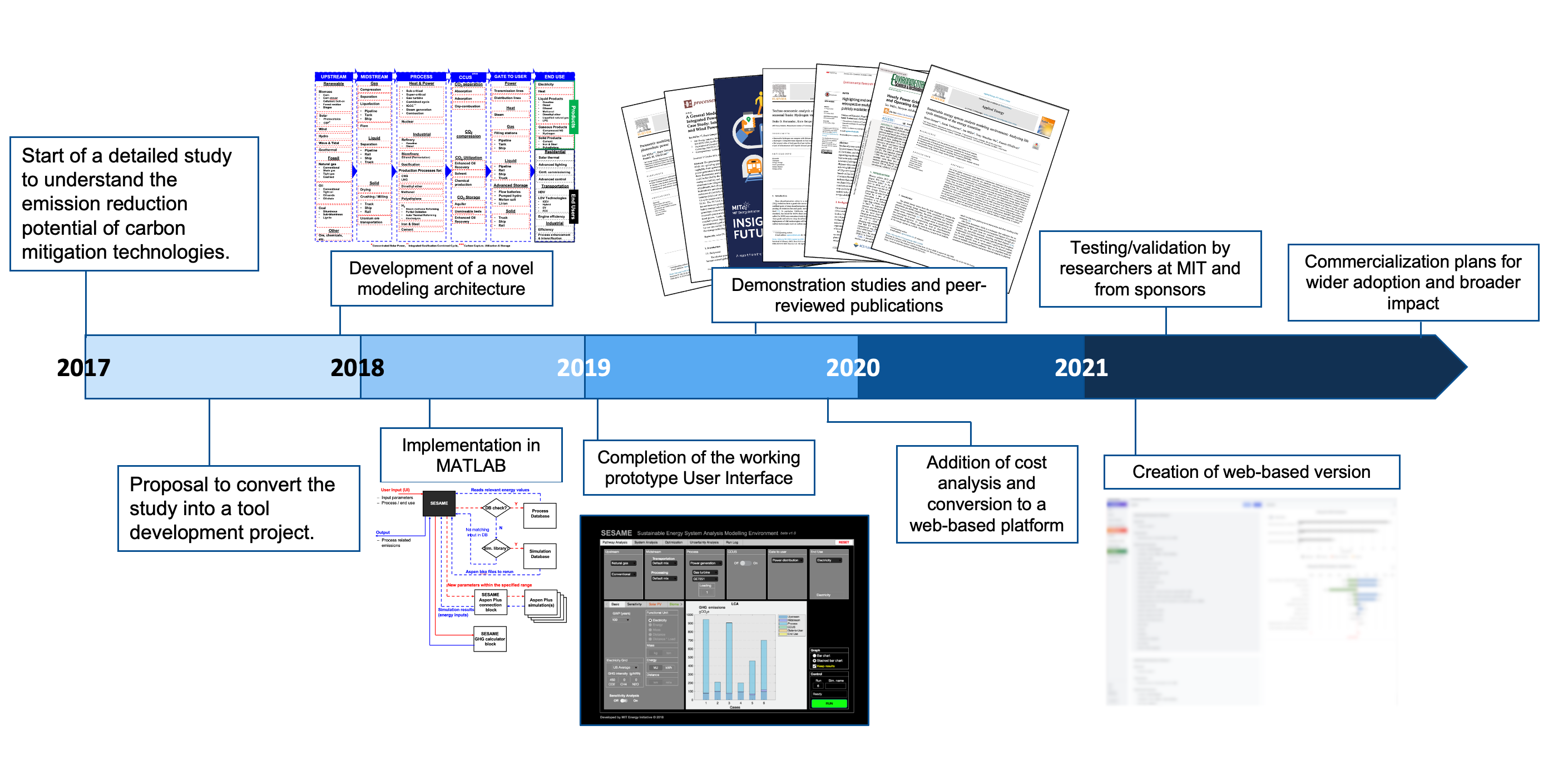

One of today’s paramount global challenges is balancing the escalating demand for energy with the imperative to drastically cut down greenhouse gas emissions across its production, distribution, and consumption phases. This transformation in the energy sector is marked by the merging of power, transportation, and industrial sectors, necessitating comprehensive inter-sectoral integration. To accurately gauge the progress in decarbonization resulting from these shifts, it is crucial to analyze the overall carbon footprint of the energy system.
In addressing this challenge, Sesame Sustainability began its journey as a sponsored research project under the MIT Energy Initiative (MITEI), focusing on “Understanding Carbon Mitigation Technologies.” The project aimed to conduct a comprehensive life cycle assessment (LCA) comparing traditional and new energy pathways within the larger context of the energy transition. Recognizing the project’s complexity, Sesame Sustainability’s co-founder and CEO, Dr. Emre Gençer, proposed the development of an advanced energy system software to effectively meet its specific goals and explore broader inquiries surrounding the energy transition.
After serving as the lead developer of SESAME (Sustainable Energy Systems Analysis and Modeling Environment) for eighteen months, Dr. Gençer assumed the role of principal investigator. Under his leadership, he secured over $7 million in research funding and oversaw a team of over thirty researchers, including post-doctoral associates, graduate students, and computer scientists. Since 2018, SESAME has yielded more than twenty publications. Most recently, Sesame technology has been used in Harnessing Hydrogen: A Key Element of the U.S. Energy Future report, a comprehensive study conducted by the National Petroleum Council (NPC) and EFI Foundation’s U.S. Hydrogen Infrastructure Action Plan report. Sponsors of SESAME project at MITEI include ExxonMobil, the International Energy Agency Gas and Oil Collaborative Program, Royal Dutch Shell, and the MITEI Low Carbon Energy Centers.

SESAME has undergone significant developmental evolution since its inception. Initially developed in MATLAB, the platform transitioned to a Python-based version. An earlier iteration of the Python-based SESAME is available here solely for archival purposes, as it is no longer maintained or updated. Sesame Sustainability has acquired commercial licenses for SESAME IP, forming the foundation of the software’s commercial edition.
Over the years SESAME research group has published numerous scientific articles and reports demonstrating the applications of the platform.
List of Articles
1. “Commercial electric vehicle fleets in US ancillary services markets: A stochastic analysis to inform utility rate design”, Utilities Policy, 2024.
2. A novel hydrogen supply chain optimization model–Case study of Texas and Louisiana, International Journal of Hydrogen Energy, 2024.
3. Environmental and economic evaluation of decarbonization strategies for the Indian steel industry, Energy Conversion and Management, 2023.
4. Highlighting regional decarbonization challenges with novel capacity expansion model, Cleaner Energy Systems, 2023.
5. Modeling Commercial Fleet Charging and Regulation Strategies via Data-driven Optimization, Computer Aided Chemical Engineering, 2023.
6. Accurately Modeling Hydropower in the USA, Computer Aided Chemical Engineering, 2023.
7. Analyzing the Large-Scale Supply of Low-Carbon Hydrogen in Germany, Computer Aided Chemical Engineering, 2023.
8. Environmental-Techno-Economic analysis of decarbonization strategies for the Indian aluminum industry, Energy Conversion and Management, 2022.
9. Can vehicle-to-grid facilitate the transition to low carbon energy systems?, Energy Advances, 2022.
10. Techno-economic analysis of balancing California’s power system on a seasonal basis: Hydrogen vs. lithium-ion batteries, Applied Energy, 2021.
11. Role of hydrogen in a low-carbon electric power system: a case study, Frontiers in energy research, 2021.
12. Back-End Design and Development of an Energy Systems Analysis Tool, Computer Aided Chemical Engineering, 2021.
13. Hourly power grid variations, electric vehicle charging patterns, and operating emissions, Environmental Science & Technology, 2020.
14. Highlighting and overcoming data barriers: creating open data for retrospective analysis of US electric power systems by consolidating publicly available sources, Environmental Research Communications, 2020.
15. Sustainable energy system analysis modeling environment: Analyzing life cycle emissions of the energy transition, Applied Energy, 2020.
16. Insights Into Future Mobility – A report from the Mobility of the Future study. MIT Energy Initiative, 2019.
17. A Framework for Multi-level Life Cycle Analysis of the Energy System, Computer Aided Process Engineering, 2019.
18. Modeling Impacts of Tracking on Greenhouse Gas Emissions from Photovoltaic Power, Computer Aided Process Engineering, 2019.
19. Parametric modeling of life cycle greenhouse gas emissions from photovoltaic power, Applied Energy, 2019.
20. A general model for estimating emissions from integrated power generation and energy storage. Case study: integration of solar photovoltaic power and wind power with batteries, Processes, 2018.
Reports
1. The Future of Energy Storage – An Interdisciplinary MIT Study. MIT Energy Initiative, 2022.
2. Plausible energy futures: A framework for evaluating options, impacts, and national energy choices, 2021.
3. Insights Into Future Mobility – A report from the Mobility of the Future study. MIT Energy Initiative, 2019.
4. Optionality, Flexibility & Innovation: Pathways for Deep Decarbonization in California. The Energy Futures Initiative Report, 2020.
Conference presentations
– Multi-Level Life Cycle Analysis Tool for Sustainable Energy Systems Modeling, AIChE Annual Meeting, Orlando, FL, 2019.
– Modeling the Impact of Solar Tracking on Life Cycle Greenhouse Gas Emissions from Photovoltaic Power, AIChE Annual Meeting, Orlando, FL, 2019.
– SESAME: A Modular Technology Assessment Tool, Workshop on Analytical Frameworks for Assessment of National Energy Options, International Energy Agency Gas & Oil Technology Collaboration Program, Paris, France, 10/30/2019.
– A Framework for Multi-level Life Cycle Analysis of the Energy System, ESCAPE 29, Eindhoven, Netherlands, 06/17/2019.
– Modeling Impacts of Tracking on Greenhouse Gas Emissions from Photovoltaic Power, ESCAPE 29, Eindhoven, Netherlands, 06/18/2019.
– (Selected for spotlight presentations) Integrated Life Cycle Analysis and Multi-level Energy Systems Modeling, SETAC Europe 29th Annual Meeting, Helsinki, Finland, 05/29/2019.
– The Hidden Emissions Impact of Operational Variability of Fossil Fuel Fired Power Plants, American Geophysical Union Fall Meeting 2018, Washington, DC, 12/11/2018.